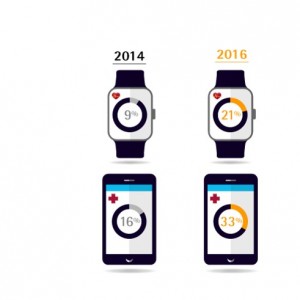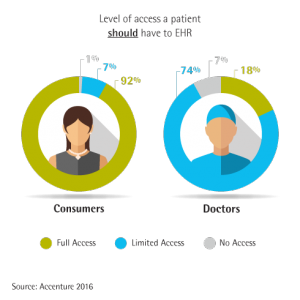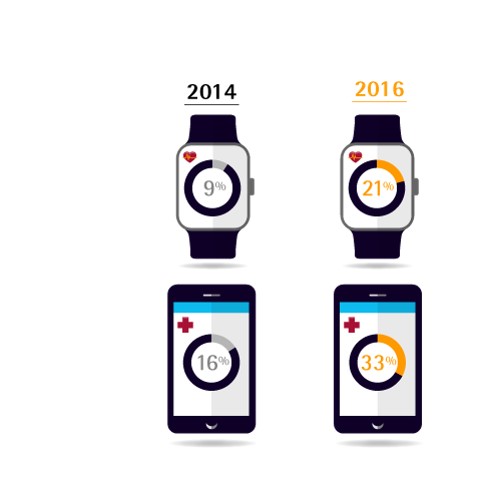 9 in 10 people in the U.S. use some form of digital technology or electronic tools for health management, Accenture found in the company’s 2016 Consumer Survey on Patient Engagement.
9 in 10 people in the U.S. use some form of digital technology or electronic tools for health management, Accenture found in the company’s 2016 Consumer Survey on Patient Engagement.
Younger people (18-34) tend to favor wearable technology, apps and social media for health. More older people (age 65-74) mine electronic health records (EHRs) for personal health data and more likely use tech for remote consultations with care providers.
Overall, the percent of U.S. consumers accessing their EHR data grew by over 50% between 2014 and 2016, from 27% to 45% of people doing so, with older people indexing higher for EHR use. The most popular types of data consumers sought in EHRs were lab and blood test results (48% in 2016), prescription medication history (44%), immunization status (37%), personal profiles (36%), billing information (35%), and physician notes about “my visit” (33%). Consumers say that the two areas of personal health information in the EHR that most helps them manage their health are lab and blood test results, and physician notes.
Fully one-third of people (35%) “do not know” what information they have access to.
Websites are the most common technology or electronic health management tool that people use, by 57% of consumers. Note that about the same percentage of all consumers across all ages, including those 56% of those age 75 and older, use websites for health management.
The use of websites is followed by mobile apps (used by 33%), EHRs (27%), wearable tech (21%), and social media (21%). The use of several other categories remained relatively flat between 2014 and 2016, including smart scales (13% vs 10%), remote consultation (12%, no growth over the 2 years), online support communities (12% vs 10%). Remote monitoring was found to be used by 8% of people in 2016 (the question not asked in the 2014 survey).
Only one in five physicians have recommended their patients use a wearable tech to monitor viral signs or fitness and lifestyle (19% and 18%, respectively). However, 76% of consumers who receive such a recommendation took the doctor’s advice and adopted the technology.
Accenture sponsored a seven-country survey of 7,840 adult (18 years and over) consumers assess attitudes about health and technology. The survey included 2,225 U.S. respondents, conducted between November 2015 and January 2016. Physician data was acquired through a separate survey.
 Health Populi’s Hot Points: Accenture asserts that “Patients want a heavy dose of digital” in a related report, which I covered here in Health Populi earlier this month. That report contrasted patients’ desire for a greater “dose,” versus physicians’ contrary view — that patients should have more limited access to their EHRs, as the second graphic clearly illustrates.
Health Populi’s Hot Points: Accenture asserts that “Patients want a heavy dose of digital” in a related report, which I covered here in Health Populi earlier this month. That report contrasted patients’ desire for a greater “dose,” versus physicians’ contrary view — that patients should have more limited access to their EHRs, as the second graphic clearly illustrates.
The 2016 patient engagement poll shows the mass of consumers, across all ages, using digital tech for various aspects of health and wellness. While not all age groups are keen on the same tools, even the oldest cohort of U.S. adults is keen on several categories including EHRs, websites, and remote monitoring.
Accenture’s survey reinforces what those of us who have adopted user-centered design in health planning and technology development already know: it’s all about the person’s life flow and the physicians’ work flow. Physicians are slow to come to this realization based on the daily pressures of practicing medicine, but consumers will express their desire to engage with digital techs in health that make their lives easier, their self-knowledge clearer, and their self-care streamlined. Physicians and health plans who do not embrace this view will experience an outflow of patients — now, consumers engaging in their health and health care — from their practices. Perhaps then with declining work flow, they will get the message in a more direct way.





 Thank you FeedSpot for
Thank you FeedSpot for